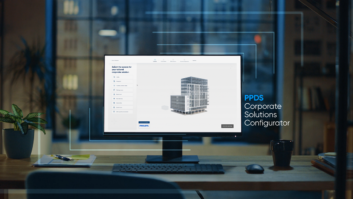
US-based distributor Stampede has made major inroads into Europe following its acquisition of Just Lamps last year. It’s also at the forefront of the drone movement in the AV world. Paddy Baker talks to its COO and president.
When you were at school what were your favourite subjects?
I really enjoyed math at school, math and science. And as I got further into it I developed an appreciation for history, although I didn’t like it at first. But my strongest suit was my math-oriented classes.
And you went out into the world, you worked for a consumer electronics retailer. Did your love for science and math steer you in that direction?
I think that my passion really became the sales and marketing of consumer electronics products. The math that I enjoyed wasn’t to do with the specification of the products but to do with the business side.
You moved to Stampede in 2001. What was behind that?
Growth and development. The retailer I was working for was a smaller family-owned company with a US presence, and at the time that was a platform that worked for me. But the opportunity came to move to Stampede: it was a company that had international owners and a sister company in the UK.
We were at the time focused only on projectors, and the plasma monitor had just come into existence. I remember the first time I described this to somebody, the gentleman asked what other healthcare equipment I was selling – he thought it was something for counting blood platelets! That’s how early in the evolution of that technology we were.
And then three years later, with your business partner, you bought the company.
It was time once again for an evolution. The ownership was certainly open to us purchasing the company, and so we put together a plan to do it. The direction that we wanted to go in, I don’t think that the previous ownership was interested in, and so it made sense for us to purchase the company and continue growing and developing it in the direction that we thought best.
And then significant growth followed on a pretty much year-on-year basis.
Yes, out of 20 years of existence we’ve had 19 years of growth, and 18 of those have been record years. Our number one objective for adding value to our manufacturer partners is to find ways to incrementally grow their sales. That is something we look to live up to every year, and we push ourselves and certainly look for our manufacturer partners to be willing partners in that process.
Can you tell me more about the British side of Stampede, and your launch into Europe?
My business partner, Mark Wilkins [Stampede CEO], is British, and he came over from the UK to start the company up under the previous ownership. We had a small business in Europe up until the point of acquiring Just Lamps. We had established Stampede Europe back in late 2014 with the intent that we were going to grow and develop the business. We had purchased a product line called TAPit, and that was the first product that we had inventory in Europe. But it was clear that there was a path forward to expand, and offer our manufacturers some real value in being able to provide them additional territories where they were not doing business.
So we decided to purchase Just Lamps – at the time it was the world’s largest projector lamp distributor. They were specialists, and they had built a wonderful business around the world. We purchased that company because they had active customers, and now we’re in the process of expanding those sales operations from being solely lamp-focused.
So by broadening the offer to those customers, you plan to overcome any decline in lamp business?
Yes. We are in the process of taking those active customers and introducing them to new product lines on a daily basis. We’ve turned the corner already in Europe where we are now selling more AV in outright dollars than we are selling lamps, after about a year.
We see continued growth in the overall market and our lamp business is doing fine. We’ll continue selling lamps for as long as people want to buy them, but we’re aggressively developing the other categories. Worldwide we have more than 200 manufacturer relationships and we have a pretty broad portfolio, about 19,000 SKUs deep, and we look to bring elements of that product portfolio to our customers that are purchasing lamps from us today.
Do you see any differences between the way that the US and European distribution markets are structured?
Manufacturers tend to slice and dice Europe up based upon relationships or preferences or internal strategy, but in the United States we typically get the entire country with one contract. So that offers us an opportunity to deliver different product portfolios in different markets. That’s probably the biggest difference.
Typically what the end-users find important, and what the integrators and retailers and resellers need from a value-added distributor in the AV category, is the same all around the world.
What are the advantages of being a globally based distributor?
There’s very few specialists in the marketplace that have the ability to serve a manufacturer in more than 70 countries. When you say the word ‘manufacturer’ most people immediately think large multinationals. But in sheer numbers there are far more regional-based manufacturers than there are multinational manufacturers; there are literally thousands of smaller manufacturers that only operate in one or two regions. That gives us an opportunity to add significant value to manufacturers that want to grow in regions that they don’t have a presence in.
Certainly we are a known commodity to many manufacturers from our success in one market or another, and that helps develop a level of credibility that that has been built over the last 20 years.
I’m proud of the fact that we will drive the spec on a deal 50% of the time
Do you see your growth as primarily organic, or is there an extent to which you’re competing with other distributors and taking manufacturers and customers from them by offering better service?
It’s both. The major driver of our growth, in outright dollars, is in existing markets where we continue to grow faster than the market. We’re not necessarily looking to take business from the competition – we’re looking for ways to drive the spec initially and be at the beginning of a project more often than our competitors. And the difference is pretty significant.
The harder we work at creating high-quality deals, the more we close, and the more we differentiate ourselves from our competitors through that process. I’m really excited about the work our sales team does with our customers every day and I’m proud of the fact that we will drive the spec on a deal 50% of the time.
In this day and age, with manufacturer salesforces being deployed at end-user level, I’m proud of that because we truly add value to our resellers. They look for our educated opinion, they rely on our expertise, and they are comfortable going with our lead on product recommendations.
Stampede has made a lot of noise in the market about drones. How have you found the demand from that market in Europe compared with the US?
The US is certainly the fastest-growing market in the world right now, and that will continue to evolve. The applications are continuing to evolve, and are working their way towards the commercial and enterprise marketplace. There’s always going to be more rapid adoption in all markets around the world by more sophisticated end-users that are using the technology to drive results.
So drones are just getting started. They are by no means a mature category in the enterprise, from a commercial standpoint. We’re thrilled that we’ve been chosen to help Intel come to market with drones in both the US and in Europe – that’s a great testimony to our expertise.
Looking at European market development, it’s going to be based on the end-user organisations understanding what the technology can do for them: reduce their costs, save time, reduce risks associated with human activities, and potentially save lives. I don’t believe that there’s a big lag between the US and Europe. The fact that the US is the fastest-growing market in the world is based on the interest that exists at the consumer level. But the next real wave that we’ve been waiting for is the commercial and enterprise-focused products, and I believe that you’re going to see both regions adopt them quickly. Because it doesn’t take long for a business to learn about what its competitors are doing and then look to achieve the same types of results itself.
What are the main applications for drones currently?
According to research, aerial photography and video is 46% of the use of drone products. The next one is surveying and mapping, and third is real estate – we can talk about real estate companies where every listing has a drone video as a standard deal. And construction follows that. You’d be surprised at the number of uses, and really we’re just getting started because the evolutions and innovation are going to continue. And that’s the exciting part.
Do you think that Stampede can continue to grow for the foreseeable future at the current rate?
We have continued to grow – we’re having a record year this year. I expect us to continue to find ways to help our manufacturers grow. Some of our manufacturers have some pretty high expectations, and we look to go ahead and exceed them.







